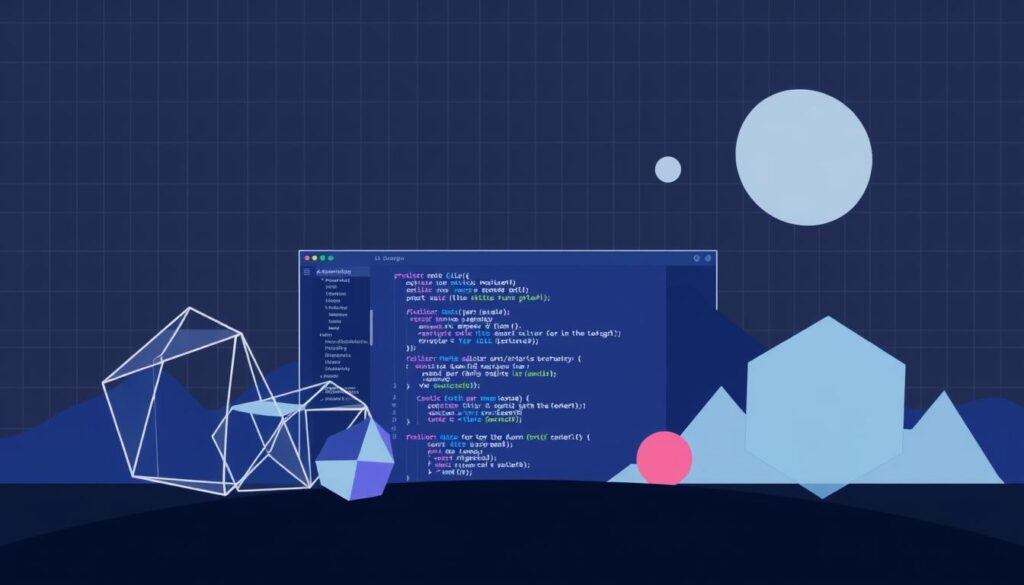As a programmer, having a solid grasp of fundamental algorithms is crucial for tackling complex problems and writing efficient code. Imagine being able to optimize your programs, making them run faster and more smoothly. This is where understanding key algorithms comes into play.
Algorithms are the backbone of programming, enabling developers to solve problems methodically. Whether you’re working on data analysis, artificial intelligence, or web development, a strong foundation in algorithms can significantly enhance your coding skills.
In this article, we’ll explore the essential algorithms that every programmer should be familiar with. We’ll delve into explanations and examples to help solidify your understanding, making it easier to apply these concepts in real-world scenarios.
Key Takeaways
- Understand the importance of algorithms in programming.
- Learn the top algorithms that are crucial for every programmer.
- Discover how these algorithms are applied in real-world scenarios.
- Enhance your coding skills with practical examples and explanations.
- Improve your problem-solving abilities with a strong foundation in algorithms.
The Importance of Algorithmic Thinking in Modern Programming
Algorithmic thinking is what differentiates good programmers from great ones, as it directly impacts code quality and performance. In modern programming, the ability to understand and apply algorithms is not just a skill; it’s a necessity. It enables developers to solve complex problems efficiently, scale their applications, and maintain a competitive edge in the tech industry.
Understanding algorithms is crucial for writing efficient code. When programmers have a solid grasp of essential algorithms for programmers, they can significantly improve the performance and scalability of their applications. This knowledge allows them to analyze problems, identify the most appropriate algorithms, and implement solutions that are both effective and efficient.
How Algorithms Impact Code Efficiency
The choice of algorithm can dramatically affect the efficiency of code. For instance, using a binary search instead of a linear search can reduce search times from linear to logarithmic complexity. This not only improves the user experience but also reduces computational resources, making the application more cost-effective to run. By understanding popular coding algorithms, developers can make informed decisions that enhance their code’s efficiency.
Building a Strong Foundation for Technical Interviews
Algorithmic knowledge is also a key factor in technical interviews. Being able to discuss and implement algorithms confidently can make a significant difference in how candidates are perceived by potential employers. It demonstrates problem-solving skills, the ability to think critically, and a grasp of fundamental programming concepts. By mastering essential algorithms for programmers, individuals can better prepare themselves for the challenges of technical interviews and increase their chances of success.
Top10 Algorithms Every Programmer Should Know
Algorithms form the backbone of programming, and knowing the right ones can make a significant difference. As a programmer, understanding the top algorithms can enhance your coding skills and open up new opportunities.
Selection Criteria for Essential Algorithms
The selection of the top 10 algorithms is based on their frequency of use, impact on performance, and applicability across various programming domains. These algorithms are considered essential due to their ability to solve complex problems efficiently.
- Sorting and searching algorithms for data manipulation
- Graph algorithms for network analysis
- Dynamic programming for optimization problems
How to Approach Learning These Algorithms
To learn these algorithms effectively, start by understanding the theory behind each one. Then, practice implementing them in different programming languages. Utilize online resources, such as coding challenges and tutorials, to reinforce your learning.

1. Binary Search: The Divide and Conquer Approach
Binary search is a fundamental algorithm in computer science that efficiently locates a target value within a sorted array. This algorithm exemplifies the divide and conquer strategy, significantly reducing the number of comparisons needed to find the target.

Understanding Binary Search Logic
The binary search algorithm works by repeatedly dividing the search interval in half. Initially, the interval includes the entire array. If the value of the search key is less than the item in the middle of the interval, the interval is narrowed to the lower half; otherwise, it is narrowed to the upper half.
This process continues until the size of the interval is zero, meaning the target value is not in the array, or until the target value is found.
Step-by-Step Implementation in Python and Java
Let’s look at how binary search can be implemented in Python and Java:
- Python Implementation:
def binary_search(arr, target): low, high = 0, len(arr) - 1 while low - Java Implementation:
public int binarySearch(int[] arr, int target) { int low = 0, high = arr.length - 1; while (low
Time Complexity Analysis and Optimization Tips
The time complexity of binary search is O(log n), making it much more efficient than linear search for large datasets. To optimize binary search, ensure that the input array is sorted, as this is a prerequisite for the algorithm to work correctly.
Some key optimization tips include using iterative methods instead of recursive ones to avoid stack overflow for very large arrays, and utilizing compiler optimizations if available.
2. Quick Sort: Efficient Sorting for Large Datasets
Quick Sort is a highly efficient sorting algorithm that uses a divide-and-conquer approach to sort large datasets. It works by selecting a ‘pivot’ element from the array and partitioning the other elements into two sub-arrays, according to whether they are less than or greater than the pivot.

The Partition Method Explained
The partition method is the core of the Quick Sort algorithm. It rearranges the array such that all elements less than the pivot are on the left, and all elements greater are on the right. This is done in-place, making Quick Sort a space-efficient sorting algorithm.
Efficient partitioning is crucial for the performance of Quick Sort. The choice of pivot can significantly affect the algorithm’s efficiency. A good pivot can lead to a balanced partition, while a poor choice can result in an unbalanced partition, affecting the overall performance.
Implementing Quick Sort with Code Examples
Here’s an example implementation of Quick Sort in Python:
def quick_sort(arr):
if len(arr) pivot]
return quick_sort(left) + middle + quick_sort(right)
This implementation demonstrates the recursive nature of Quick Sort, where the array is recursively divided into smaller sub-arrays until each sub-array contains only one element.
Performance Comparison with Other Sorting Algorithms
Quick Sort’s average-case time complexity of O(n log n) makes it suitable for sorting large datasets. However, its worst-case performance can be O(n^2) if the pivot is chosen poorly. In comparison, algorithms like Merge Sort and Heap Sort have a guaranteed O(n log n) time complexity, making them more predictable but potentially slower than Quick Sort for many use cases.
3. Breadth-First Search (BFS): Level-Order Traversal
In the realm of graph and tree traversal, Breadth-First Search stands out as a crucial algorithm that every programmer should know. BFS is a widely used algorithm that enables the traversal of graphs and trees in a level-order manner, making it a cornerstone in programming.

Queue-Based BFS Implementation
The BFS algorithm is typically implemented using a queue data structure. The process begins by enqueueing the starting node, then dequeuing it and enqueueing its unvisited neighbors. This process continues until the queue is empty, ensuring that nodes are visited in level order. As Donald Knuth once said, “The art of programming is the art of organizing complexity, of arranging things in such a way that difficulties are minimized and the programmer can focus on the important issues.”
Using a queue, BFS efficiently traverses the graph or tree, making it particularly useful for finding the shortest path in unweighted graphs.
Coding BFS for Graphs and Trees
Implementing BFS for both graphs and trees involves similar steps, with the primary difference being the handling of visited nodes to avoid infinite loops in graphs. Here’s a basic example in Python:
from collections import deque
def bfs(graph, root):
visited = set()
queue = deque([root])
visited.add(root)
while queue:
vertex = queue.popleft()
print(vertex, end=" ")
for neighbour in graph[vertex]:
if neighbour not in visited:
visited.add(neighbour)
queue.append(neighbour)
This code snippet demonstrates how to traverse a graph using BFS, printing the visited nodes.
Practical Applications in Social Networks and Web Crawling
BFS has numerous practical applications, including social network analysis, where it can be used to find friends of friends, and web crawling, where it helps in discovering new web pages by following links from known pages. As stated by a leading researcher, “The power of BFS lies in its simplicity and efficiency, making it a fundamental tool in network analysis.”
4. Depth-First Search (DFS): Exploring Paths to Completion
When it comes to exploring complex data structures, Depth-First Search (DFS) is one of the most essential algorithms to understand. DFS is a traversal approach that explores as far as possible along each branch before backtracking.
Recursive vs. Iterative DFS Approaches
DFS can be implemented in two primary ways: recursively and iteratively. The recursive approach is often more straightforward to understand and implement, as it involves calling the DFS function within itself for each neighbor of the current node.
In contrast, the iterative approach uses a stack data structure to manually manage the nodes to be visited, avoiding the potential stack overflow issues associated with deep recursions.
- Recursive DFS: Simple to implement but may cause stack overflow for very deep graphs.
- Iterative DFS: More complex to implement but handles large graphs without recursion limits.
DFS Implementation with Stack Data Structure
Implementing DFS iteratively involves using a stack to keep track of nodes to visit. The process starts by pushing the starting node onto the stack, then entering a loop where the top node is popped, processed, and its unvisited neighbors are pushed onto the stack.
“The use of a stack in DFS allows for an efficient traversal by ensuring that the most recently discovered nodes are explored first.” – Algorithm Expert
This method is particularly useful for searching in graphs where the depth is significant, and recursion might not be feasible.
Solving Maze Problems and Path Finding with DFS
DFS is particularly useful in solving maze problems and pathfinding. By treating the maze as a graph where paths are edges and intersections are nodes, DFS can efficiently explore all possible paths to find a solution.
Key applications include:
- Maze solving
- Path finding in complex networks
- Topological sorting
By mastering DFS, developers can tackle a variety of complex problems involving graph and tree traversals, making it one of the basic algorithms for coding and a must-know algorithm for developers.
5. Dijkstra’s Algorithm: Finding the Shortest Path
In the realm of graph algorithms, Dijkstra’s Algorithm stands out for its efficiency in path finding. This algorithm is pivotal in determining the shortest path between nodes in a graph, making it a fundamental component in various applications.

The Greedy Approach to Path Finding
Dijkstra’s Algorithm employs a greedy approach, selecting the next node with the shortest distance that hasn’t been processed yet. This method ensures that the algorithm always chooses the most promising path, leading to an efficient solution.
The greedy strategy is particularly effective in this context because it allows the algorithm to focus on the most relevant paths, avoiding unnecessary explorations.
Priority Queue Implementation of Dijkstra’s Algorithm
A priority queue is crucial for implementing Dijkstra’s Algorithm efficiently. By using a priority queue, the algorithm can quickly identify and process the node with the shortest distance.
This implementation is key to the algorithm’s performance, as it enables fast updates of distances and ensures that the node with the minimum distance is always processed next.
Applications in GPS Navigation and Network Routing
Dijkstra’s Algorithm has numerous applications, particularly in GPS navigation and network routing. Its ability to find the shortest path makes it invaluable in these fields, where efficiency and accuracy are critical.
By understanding and implementing Dijkstra’s Algorithm, developers can create more efficient and reliable navigation and routing systems.
6. Dynamic Programming: Breaking Problems into Subproblems
Breaking down complex problems into manageable subproblems is the essence of dynamic programming, a method that has revolutionized the way programmers approach challenging tasks. Dynamic programming is particularly useful for problems that have overlapping subproblems or that can be decomposed into smaller subproblems.

Top-Down vs. Bottom-Up Approaches
Dynamic programming can be approached in two primary ways: top-down and bottom-up. The top-down approach involves breaking down the problem into smaller subproblems and solving them recursively, often with the help of memoization to store the results of subproblems to avoid redundant computation. On the other hand, the bottom-up approach starts with the smallest subproblems, solves them, and then combines their solutions to solve larger problems. This approach is typically iterative and can be more efficient as it avoids the overhead of recursive calls.
The choice between top-down and bottom-up depends on the problem and the programmer’s preference. Top-down is often more intuitive as it follows the natural recursive structure of the problem, while bottom-up can be more efficient in terms of memory and computation.
Classic Examples: Fibonacci and Knapsack Problems
Two classic examples that illustrate the power of dynamic programming are the Fibonacci sequence and the 0/1 Knapsack problem. The Fibonacci sequence is a series of numbers where a number is the sum of the two preceding ones, usually starting with 0 and 1. Calculating Fibonacci numbers is a straightforward application of dynamic programming, where each number is computed only once and stored for future reference.
The 0/1 Knapsack problem is a combinatorial problem where, given a set of items, each with a weight and a value, one must determine the subset of these items to include in a knapsack of limited capacity that maximizes the total value. Dynamic programming solves this by creating a 2D table where each cell represents the maximum value that can be obtained with a given capacity and considering the items up to a certain point.
Identifying Dynamic Programming Problems
To identify if a problem can be solved using dynamic programming, look for two key properties: overlapping subproblems and optimal substructure. Overlapping subproblems occur when the same subproblem is solved multiple times. Optimal substructure means that the problem can be broken down into subproblems, and the optimal solution to the larger problem can be constructed from the optimal solutions of the subproblems. Recognizing these properties is crucial for applying dynamic programming effectively.
7. Hash Tables: O(1) Lookup Time Data Structures
Hash tables are a fundamental data structure in computer science, offering O(1) lookup time that makes them indispensable for efficient data retrieval. At their core, hash tables are designed to store and retrieve data quickly by mapping keys to values using a hash function.
The efficiency of hash tables lies in their ability to perform operations such as search, insert, and delete in constant time, making them highly efficient for large datasets. This is particularly useful in applications where data needs to be accessed rapidly, such as in caching mechanisms, database indexing, and more.
Hash Functions and Collision Resolution Strategies
A crucial component of hash tables is the hash function, which determines how keys are mapped to indices of a backing array. A good hash function should be deterministic, non-injective, and fixed output size. However, collisions can occur when two different keys hash to the same index. To mitigate this, collision resolution strategies such as chaining (using linked lists) and open addressing (probing for the next available slot) are employed.
Collision resolution is critical because it directly impacts the performance of the hash table. Techniques like linear probing, quadratic probing, and double hashing are used in open addressing to find an empty slot when a collision occurs.
Building a Custom Hash Table from Scratch
To truly understand hash tables, it’s beneficial to build one from scratch. This involves designing a hash function, implementing collision resolution, and handling resizing when the load factor becomes too high. The load factor is the ratio of the number of elements to the table size, and maintaining an optimal load factor is crucial for performance.
Here’s a simple example of a hash table implementation in Python:
class HashTable:
def __init__(self, size):
self.size = size
self.table = [[] for _ in range(size)]
def _hash_function(self, key):
return hash(key) % self.size
def insert(self, key, value):
index = self._hash_function(key)
for pair in self.table[index]:
if pair[0] == key:
pair[1] = value
return
self.table[index].append([key, value])
def get(self, key):
index = self._hash_function(key)
for pair in self.table[index]:
if pair[0] == key:
return pair[1]
return None
This example demonstrates a basic hash table with chaining for collision resolution.

Hash Tables in Language Libraries and Frameworks
Most programming languages provide built-in support for hash tables through libraries or native data structures. For example, Python’s dictionaries, Java’s HashMap, and JavaScript’s objects are all implementations of hash tables. Understanding how these work under the hood can help developers make informed decisions about when to use them and how to optimize their usage.
As a developer, knowing the intricacies of hash tables can significantly enhance your ability to design efficient algorithms and data structures, making you more proficient in tackling complex problems.
8. Merge Sort: Stable and Predictable Performance
Among the top algorithms explained, Merge Sort stands out for its efficiency in sorting large datasets. This algorithm is a prime example of the divide-and-conquer approach, where the data is divided into smaller chunks, sorted, and then merged back together in a sorted manner.
The Merge Operation Explained
The core of Merge Sort lies in its merge operation. This process involves taking two sorted subarrays and merging them into a single sorted array. It’s a straightforward yet powerful technique that ensures the final output is sorted correctly.
Step-by-Step Merge Operation:
- Compare the first elements of both subarrays.
- Place the smaller element into the new array.
- Move to the next element in the subarray from which the element was taken.
- Repeat until all elements are merged.
Implementing Merge Sort in Multiple Languages
Merge Sort can be implemented in various programming languages. Below are examples in Python and Java, demonstrating its versatility.
Python Implementation:
def merge_sort(arr): if len(arr)Java Implementation:
public class MergeSort { public static void mergeSort(int[] arr) { if (arr.lengthWhen to Choose Merge Sort Over Other Algorithms
Merge Sort is particularly useful when dealing with large datasets that don't fit into memory, as it can be adapted for external sorting. It's also a good choice when stability is required, meaning the order of equal elements is preserved.
| Algorithm | Time Complexity (Best) | Time Complexity (Average) | Time Complexity (Worst) | Space Complexity |
|---|---|---|---|---|
| Merge Sort | O(n log n) | O(n log n) | O(n log n) | O(n) |
| Quick Sort | O(n log n) | O(n log n) | O(n^2) | O(log n) |
| Heap Sort | O(n log n) | O(n log n) | O(n log n) | O(1) |
As shown in the table, Merge Sort offers consistent performance across different scenarios, making it a reliable choice for many applications.
9. Tree Traversal Algorithms: Navigating Hierarchical Data
Tree traversal algorithms are essential for navigating and manipulating hierarchical data structures efficiently. These algorithms allow developers to visit each node in a tree data structure in a specific order, making it possible to perform operations such as searching, inserting, and deleting nodes.
In-order, Pre-order, and Post-order Traversal Techniques
There are three primary techniques used in tree traversal: in-order, pre-order, and post-order traversal. In-order traversal visits the left subtree, the current node, and then the right subtree. This technique is particularly useful for binary search trees, as it allows nodes to be visited in ascending order.
Pre-order traversal visits the current node before its child nodes, making it useful for creating a copy of a tree. Post-order traversal visits the child nodes before the current node, which is helpful for deleting a tree, as it ensures that child nodes are processed before their parents.
- In-order traversal: Left -> Current -> Right
- Pre-order traversal: Current -> Left -> Right
- Post-order traversal: Left -> Right -> Current
Recursive and Iterative Implementation Examples
Tree traversal algorithms can be implemented both recursively and iteratively. Recursive implementations are often simpler to understand and code, as they directly mirror the recursive definition of a tree. However, they can be less efficient and may cause stack overflow errors for very deep trees.
Iterative implementations, on the other hand, use a stack or queue data structure to traverse the tree, avoiding the risk of stack overflow. For example, an iterative in-order traversal can be achieved using a stack to keep track of nodes to visit.
- Recursive In-order Traversal Example:
void inOrderTraversal(Node node) { if (node != null) { inOrderTraversal(node.left); System.out.println(node.value); inOrderTraversal(node.right); } } - Iterative In-order Traversal Example:
void inOrderTraversal(Node root) { Stack<Node> stack = new Stack<>(); Node current = root; while (current != null || !stack.isEmpty()) { while (current != null) { stack.push(current); current = current.left; } current = stack.pop(); System.out.println(current.value); current = current.right; } }
Applications in Expression Parsing and Directory Systems
Tree traversal algorithms have numerous applications, including expression parsing and directory systems. In expression parsing, trees represent the syntactic structure of expressions, and traversal algorithms are used to evaluate or simplify these expressions.
In directory systems, tree traversal is used to navigate through the directory hierarchy, performing operations such as listing files, searching for specific files, or calculating disk usage.
10. Graph Algorithms: Minimum Spanning Tree and Beyond
Understanding graph algorithms is essential for tackling a wide range of computational problems, from network design to clustering. Graph algorithms have numerous applications, with Minimum Spanning Tree (MST) being a critical concept.
Kruskal’s vs. Prim’s Algorithm Comparison
Kruskal’s algorithm works by sorting all edges in non-decreasing order of their weights and then selecting the smallest edge that does not form a cycle. In contrast, Prim’s algorithm starts with a random node and grows the tree by adding the smallest edge connected to the existing tree.
Kruskal’s Algorithm: More efficient for sparse graphs. Prim’s Algorithm: Performs better on dense graphs.
Implementing MST Algorithms with Code Examples
Implementing these algorithms requires a good understanding of data structures like disjoint sets for Kruskal’s and priority queues for Prim’s. For example, Kruskal’s algorithm can be implemented using the following code:
/* Sample Kruskal's Algorithm Implementation */
class Graph {
// Implementation details
}
Similarly, Prim’s algorithm can be implemented using a priority queue to efficiently select the minimum-weight edge.
Real-World Applications in Network Design and Clustering
Graph algorithms have numerous real-world applications, including network design, where MST algorithms help in designing minimum-cost networks, and clustering, where they aid in grouping related data points. As noted by
“The study of graph algorithms is fundamental for any aspiring programmer.”
Conclusion: Mastering Algorithms for Career Growth
Mastering the top10 algorithms every programmer should know is a crucial step in career growth. These basic algorithms for coding form the foundation of efficient and effective programming. By understanding and implementing algorithms like Binary Search, Quick Sort, and Dijkstra’s Algorithm, programmers can significantly enhance their coding skills.
As you’ve seen throughout this article, each of these algorithms has its unique applications and benefits. From optimizing data retrieval with Binary Search to solving complex path-finding problems with Dijkstra’s Algorithm, the right algorithm can make a significant difference in code performance.
Continuing to learn and practice these top10 algorithms will not only improve your coding abilities but also open up new opportunities in your career. As technology evolves, the demand for skilled programmers who can efficiently solve complex problems will continue to grow.
By focusing on mastering these basic algorithms for coding, you’ll be well-prepared to tackle the challenges of the ever-changing tech landscape and take your programming career to the next level.
